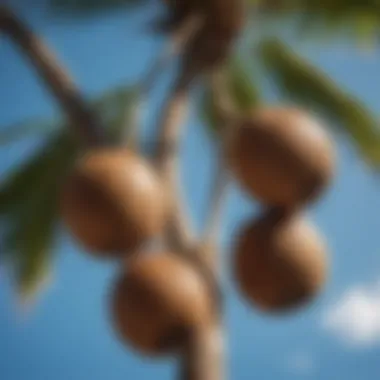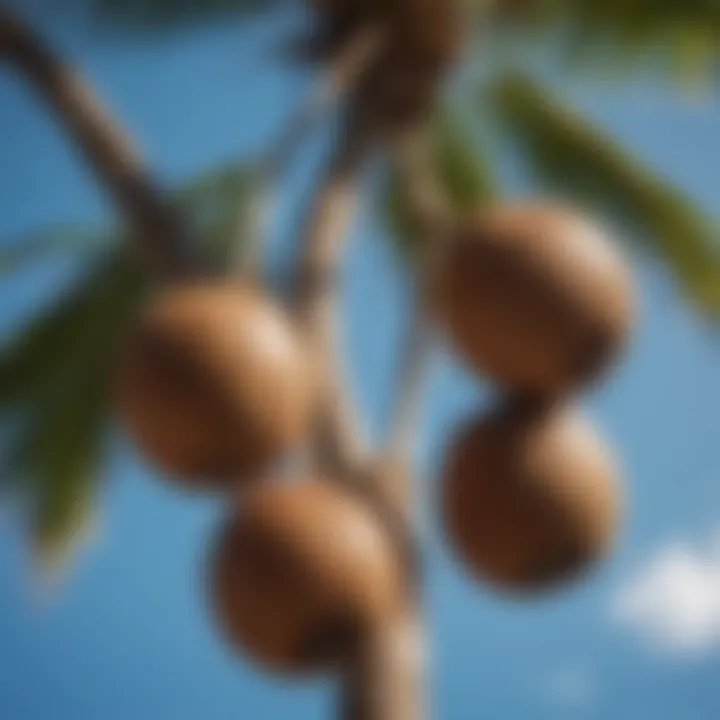Coconut Palm in St. Lucia: Significance and Impact


Intro
The coconut palm is more than just a tree in St. Lucia; it is a cornerstone of the island's identity, reflecting its culture, economy, and environmental landscape. This article aims to explore the multifaceted role of the coconut palm by examining its botanical features, cultural significance, economic contributions, and ecological impact.
Understanding the importance of the coconut palm involves looking at various aspects. It is a vital source of sustenance, a significant contributor to local industry, and an integral part of the island's aesthetics. By delving into these dimensions, we aim to provide a comprehensive guide that illustrates the coconut palm's role in shaping life in St. Lucia. Together, we will navigate its rich history, current relevance, and future prospects, ensuring a complete perspective on this remarkable tree.
To begin, let us consider some techniques and tips that can enhance our understanding of the coconut palm's significance.
Preamble to Coconut Palm
The coconut palm holds a unique place in the landscape and culture of St. Lucia. Its significance is not just rooted in its aesthetic appeal but in its multifaceted uses and integral role in the local ecosystem. Understanding the coconut palm is essential for appreciating both the natural beauty and the economic value it brings to the island.
The coconut palm is known for its resilience and adaptability in tropical environments. Its towering presence can be seen along beaches and in gardens, where it thrives under warm temperatures and abundant sunlight. The palm's importance extends beyond ornamental purposes, as nearly every part of the tree is utilized in some manner—be it for food, construction, or craftwork.
Moreover, the coconut palm serves as a symbol of island life and culture. It has been part of St. Lucian traditions, connecting generations through usage and folklore. Exploring its botanical characteristics provides insights into how this remarkable tree sustains the environment and serves the needs of local communities, making it an essential topic for this exploration.
Botanical Characteristics
The scientific name for the coconut palm is Cocos nucifera. This tree typically grows 20 to 30 meters in height. Its trunk is slender and can reach up to 90 centimeters in diameter, often leaning under strong winds. The leaves, called fronds, are long and feathery, featuring numerous leaflets. One distinguishing feature of the coconut palm is its ability to produce fruit year-round, providing a continuous source of coconuts, which mature in about 6 to 12 months.
The tree's root system is shallow but widespread, making it particularly vulnerable to environmental changes. However, it is also this adaptability that allows it to thrive in coastal areas where other vegetation may struggle.
Coconut Palm Varieties
There are several varieties of coconut palms found in St. Lucia. Each has its own characteristics and uses. Two primary species are the tall coconut palm and the dwarf coconut palm.
- Tall Coconut Palm: This variety can grow up to 30 meters and is known for its robust trunk and significant height. They are often preferred for commercial coconut production due to their high yield and longevity.
- Dwarf Coconut Palm: Smaller in stature, under 10 meters tall, the dwarf variety matures faster and produces coconuts in a shorter time frame. This makes it an attractive option for home gardeners looking for quick returns.
Both varieties not only provide coconuts, but also offer valuable timber and fibers. Understanding these differences helps recognize the importance of the coconut palm in various sectors such as agriculture, construction, and crafts in St. Lucia.
Geographical Distribution in St. Lucia
Understanding the geographical distribution of the coconut palm in St. Lucia is crucial for appreciating its role in the local ecosystem. This section explores the habitats and growth conditions that favor this species, as well as notable locations where the coconut palm flourishes.
Habitat and Growth Conditions
The coconut palm thrives in coastal regions, where saline conditions are present. In St. Lucia, it prefers sandy soils, which facilitate drainage and protect the roots from rot. The tree flourishes in full sunlight, growing best in temperatures averaging between 25°C to 30°C. Given St. Lucia's tropical climate, characterized by a wet and dry season, conditions are typically favorable for the growth of the coconut palm.
In the wetter months, rainfall ensures that the palm receives adequate hydration. In contrast, during drier periods, the tree's deep root system helps it access moisture from lower soil layers. It is important to note that while coconut palms are resilient, they can be vulnerable to strong winds and storms. This is particularly relevant considering the hurricane seasons that impact the Caribbean region.
Notable Locations
Several locations in St. Lucia are renowned for their abundant coconut palm populations. The most prominent areas include:
- Vieux Fort: This coastal town has extensive coconut palm plantations, providing a picturesque landscape and supporting the local economy.
- Soufrière: Nestled between the mountains and the sea, Soufrière features palm-fringed beaches that highlight the natural beauty of the area, attracting many visitors.
- Anse Chastanet: Known for its stunning beaches and underwater marine life, this location is also home to clusters of coconut palms, creating a unique blend of natural attractions.
- Marigot Bay: This scenic bay showcases coconut palms lining the water's edge, offering a tranquil environment that exemplifies the island's beauty.
"Coconut palms are not just trees; they are an integral part of St. Lucia's identity and landscape."


The distribution of the coconut palm contributes significantly to St. Lucia's environmental aesthetics and economic activities. Local communities not only utilize coconuts for food and construction but also engage in tourism, capitalizing on the majestic sight of palms swaying by the coast. The interaction between the coconut palm and its surroundings in St. Lucia deserves deeper analysis and appreciation.
Cultural Significance
The cultural impact of the coconut palm in St. Lucia extends far beyond its physical presence. This tree is not merely a part of the landscape; it is a vital element of local identity, reflecting historical narratives and social practices. Its role is deeply embedded in the lore and daily life of the people, thus showcasing the integral connection between nature and culture in the region.
Historical Context
Historically, the coconut palm has served as a symbol of prosperity and sustenance. When the coconut was introduced to St. Lucia, it found fertile ground to flourish. This tree provided food, shelter, and materials. Its significance in the 18th and 19th centuries can be seen in how it supported the local economies, especially through agriculture and trade.
Coconuts were harvested and processed to create goods for local consumption and export. Before plantations were established, individual households relied on the coconut palm for various needs, from culinary uses to crafting tools. The cooperative nature of these early practices laid the foundation for strong community ties.
"The coconut palm stands as a testament to resilience and adaptability, reflecting the history of St. Lucia itself."
Today, the coconut palm continues to be viewed as a cultural emblem, representing the island’s rich heritage. Various folklore and legends around the coconut strengthen its historical context, showing how intertwined this tree is with the identity of St. Lucians.
Traditions and Festivals
The coconut palm features prominently in many St. Lucian festivals and traditions. Events such as La Rose and La Marguerite honor the island's history and diversity, often involving coconut-based foods and decorations. These celebrations provide insight into how the coconut palm contributes to cultural identity.
Furthermore, specific practices during harvest season illustrate the communal approach to its bounty. Locals gather to partake in activities that not only focus on harvesting but also on sharing stories and experiences, fostering a sense of unity.
Coconut In Culinary Celebrations:
- Coconut Oil Production: Traditionally, families create their coconut oil, a staple in local cuisine.
- Coconut-Based Dishes: Recipes such as coconut bread, stews, and desserts highlight the importance of the coconut during festive seasons.
This engagement cultivates a cultural memory that reinforces the community's bond with the coconut palm, intertwining it with their sense of identity. The coconut palm thereby emerges not just as a tree but as a living symbol and contributor to the vibrant cultural tapestry of St. Lucia.
Economic Impact
The economic impact of the coconut palm in St. Lucia cannot be underestimated. This tree contributes significantly to local livelihoods and national revenue. As a resource, it offers a variety of products, from food to raw materials for diverse industries. More importantly, the coconut palm supports the economy through agriculture and tourism, both of which are vital sectors in St. Lucia's growth strategy. By examining this impact, we can understand why preserving and promoting the coconut palm is crucial for the island's future.
Coconut Industry Overview
The coconut industry in St. Lucia encompasses farming, manufacturing, and retail. Farmers grow coconut palms primarily for copra production, which is dried coconut flesh used for oil extraction. The coconut oil market continues to thrive, providing profits not only to farmers but also to local businesses involved in the processing and sale.
Additionally, coconuts are not solely limited to oil. They are a source of fresh drinking water and a key ingredient in traditional dishes that attract culinary enthusiasts. Products like coconut milk and cream are important for both local cuisine and export opportunities. As demand rises globally for natural and health-conscious products, the coconut industry stands to gain. This positions the coconut palm as a vital asset to the nation’s agricultural landscape.
Employment Opportunities
The coconut industry generates considerable employment opportunities. From cultivation to processing, it requires manpower across various stages. Many locals depend on coconut farming for their livelihood, especially in rural areas where job options are often limited. The industry provides seasonal work during harvest times and permanent roles in processing facilities.
Moreover, coconut-related businesses lead to job creation in allied sectors such as packaging, transportation, and retail. These jobs contribute to community stability and growth. As the local coconut market expands, the industry holds potential for further job creation, making it pivotal for economic development in St. Lucia.
Export Potential
Export potential in the coconut industry is growing, as global markets demand more coconut-based products. Aside from traditional exports like copra, there is increasing interest in virgin coconut oil and coconut water. Countries around the world are recognizing the benefits of these products, leading to higher export opportunities for St. Lucia.
Importantly, the geographic location of St. Lucia serves as an advantage for reaching North American and European markets. With effective marketing strategies, St. Lucia could further position itself as a significant player in the global coconut market. The island is poised to develop its exports while ensuring high-quality standards are met.


"The coconut palm not just sustains local life; it also fuels the economy with immense potential for growth tied to global markets."
In summary, the economic impact of the coconut palm in St. Lucia is multifaceted. It supports an essential industry that contributes to both local and national economies. With the continued focus on sustainability and market expansion, the future of coconut farming holds promising prospects for St. Lucia.
Environmental Considerations
The environmental considerations surrounding the coconut palm in St. Lucia are crucial for appreciating its contribution to both the ecosystem and local communities. As a keystone species, the coconut palm supports diverse biological life and has significant ecological footprints. Its ability to thrive in coastal regions makes it vital for combating beach erosion and preserving biodiversity.
Ecosystem Role
Coconut palms serve multiple roles in local ecosystems. They provide habitat and food for various species, such as birds and insects. The flowering of coconut palms attracts pollinators, contributing to a healthier environment.
Additionally, their extensive root systems help stabilize sandy soils and control coastal erosion. The fallen leaves and nuts create natural mulch that benefits the soil health, promoting microorganisms crucial for nutrient cycling. This nurturing environment enhances plant growth, which is significant for sustaining other local flora.
Furthermore, coconut palms contribute to carbon sequestration—an important process for mitigating climate change. Their growth absorbs carbon dioxide while releasing oxygen, fostering a balanced atmosphere. In essence, the coconut palm's role in the ecosystem transcends its mere fruit-bearing capacity. It acts as a protector and enhancer of local ecosystems, making it a valuable asset to St. Lucia.
Sustainability Issues
While the coconut palm presents various ecological benefits, there are sustainability issues associated with its cultivation and management. Overexploitation of coconut resources can lead to soil degradation and reduced biodiversity. Intensive farming practices often compromise the health of the environment.
Some specific sustainability challenges include:
- Land Use Changes: Conversion of land for coconut cultivation impacts native species and overall biodiversity.
- Monoculture Practices: Focusing solely on coconut palm farms can lead to pest outbreaks, as there is a lack of diversity in plant species to disrupt pest cycles.
- Water Resources: The heavy water requirements for coconut cultivation can strain local water supplies, particularly in regions already facing water scarcity.
To address these issues, it's essential to implement sustainable practices such as agroforestry, integrated pest management, and proper water management techniques. By balancing palm cultivation with environmental conservation, St. Lucia can maximize both its agricultural yields and ecological health. As we look to the future, recognizing these sustainability concerns will be vital in ensuring the coconut palm remains a sustainable resource for generations to come.
Culinary Uses
Culinary uses of the coconut palm in St. Lucia extend far beyond mere flavor enhancement. They are ingrained in the culture, economy, and everyday life of the locals. Coconut products are versatile and incorporate a unique blend of nutritional qualities. These characteristics not only satisfy culinary needs but also enrich local traditions.
Coconut-Based Dishes
In St. Lucia, coconut is a staple ingredient in various dishes, enhancing flavors and textures. One of the most popular dishes is coconut curry shrimp, where fresh shrimp is cooked in a creamy coconut sauce infused with spices. Another notable dish is green coconut water rice, providing a delightful aromatic experience that elevates a simple meal.
Locals also prepare coconut pie, a sweet treat that highlights the rich and creamy qualities of coconut meat. Additionally, cocobread is often served with meals, offering a subtle yet distinctive flavor profile. Coconut milk is widely used as a base for many soups and stews, contributing both richness and nutritional benefits.
"Coconut-based dishes symbolize more than food. They represent the culture and lifestyle of St. Lucians, connecting communities through shared culinary experiences."
Beyond traditional cuisine, coconut is also instrumental in contemporary culinary practices. Modern chefs experiment with coconuts, incorporating them into diverse global recipes. Thus, the contribution of the coconut palm is substantial in both traditional and modern culinary landscapes.
Health Benefits
Coconuts offer multiple health benefits that are often overlooked. They are a rich source of medium-chain triglycerides (MCTs), which provide quick energy. MCTs can assist in weight management and improve metabolic function. Furthermore, coconut water is low in calories and high in electrolytes, making it an excellent hydration option for active individuals.
The meat of the coconut is filled with dietary fiber, aiding in digestion and promoting gut health. Moreover, coconuts contain antioxidants that combat free radicals, supporting overall health and reducing the risk of chronic diseases. Many locals believe that the regular consumption of coconut products contributes to their vibrancy and longevity.
In summary, culinary uses of the coconut palm in St. Lucia go beyond its application in dishes. It intertwines with local identity, offers a blend of flavors and health benefits, and underscores the significance of this remarkable tree. Understanding these aspects enables a deeper appreciation of coconut palms within St. Lucia's vibrant culture and daily life.
Tourism and Coconut Palm


The coconut palm is central to the tourism landscape in St. Lucia. Its presence not only enhances the natural beauty of the island but also plays a key role in attracting visitors. The tree is often associated with tropical imagery and relaxation, which resonates with travelers seeking a serene escape.
Impact on the Tourism Industry
Coconut palms significantly impact the tourism industry. Tourists often view them as symbols of paradise, often associating their presence with pristine beaches and lush landscapes. Many resorts and hotels make use of coconut palms in their marketing to create an idyllic atmosphere.
The growing eco-tourism trend also emphasizes sustainable travel. Coconut palms contribute to this by providing local products like coconut oil, which many tourists seek. Visitors engage in activities such as touring coconut plantations or attending workshops that demonstrate the traditional uses of coconuts. Such experiences enrich the visitor's understanding of local culture and the environment.
"Coconut palms are more than just trees; they represent a way of life for many in St. Lucia."
Coconut-Themed Attractions
Numerous attractions across the island celebrate the coconut palm. Some key coconut-themed experiences include:
- Coconut Festivals: These events showcase local cuisine, crafts, and traditions centered around coconuts. They attract visitors eager to immerse themselves in the local culture.
- Coconut Products Stores: Shops that specialize in coconut-based goods offer an authentic shopping experience. From coconut oil to handicrafts, these products often draw in tourists looking for unique mementos.
- Guided Tours: Many tour operators feature excursions to coconut farms. Visitors can learn about the cultivation process, harvesting techniques, and the multiple uses of coconuts.
- Coconut Beach Bars: Located along coastal areas, these bars serve cocktails made with fresh coconut water. They provide a relaxed atmosphere where visitors can enjoy the island's beauty.
In summary, the coconut palm's influence on tourism in St. Lucia is profound. Its cultural significance, paired with the natural allure it brings to the landscape, enhances the travel experience for many visitors.
Future Perspectives
The future of the coconut palm in St. Lucia is an area that warrants considerable attention. This section will explore both the challenges and opportunities that lie ahead for this vital natural resource. By examining these aspects, we can better understand the coconut palm's resilience and its potential role in shaping St. Lucia's future.
Challenges Ahead
Several challenges face the coconut palm industry in St. Lucia. One significant issue is climate change. Increasingly severe weather patterns can directly impact the growth conditions for these palms. More intense storms and changing rainfall patterns can damage crops, leading to economic instability.
Along with climate issues, pests and diseases pose another threat. The coconut palm is susceptible to various diseases that can devastate local groves. For example, the lethal yellowing disease has had catastrophic impacts in some regions. Thus, an effective response strategy is critical to combating these threats.
Economic challenges also exist. The fluctuating market prices of coconuts can make it difficult for farmers to plan for the future. As a result, many might consider alternative crops that promise better returns, potentially jeopardizing the coconut industry.
Opportunities for Growth
Despite these challenges, opportunities for growth in the coconut palm sector remain significant. One promising avenue lies in value-added products. By creating coconut-based products like oil, flour, and cosmetics, producers can tap into higher profit margins and meet growing consumer demand for natural and organic items.
Furthermore, eco-tourism presents another potential growth area. The coconut palm could be marketed not just as a crop, but as an experience. Tourists often seek authentic local experiences. Therefore, creating tours that include coconut harvesting or workshops on coconut-based cooking could attract more visitors and generate additional revenue for local economies.
Investment in sustainable practices is also critical. By adopting eco-friendly farming methods, the region can enhance the health of its ecosystems. Modern agricultural practices combined with traditional knowledge can lead to increased yields while preserving the environment.
In summary, while the coconut palm industry in St. Lucia faces challenges, the potential for innovative growth remains high. By addressing threats proactively and seizing emerging opportunities, the coconut palm can continue to be a staple of both the economy and the culture in St. Lucia.
"The future of the coconut palm is not only in its ability to survive but also to thrive in a changing world."
By focusing on these aspects, we can ensure the ongoing relevance and sustainability of the coconut palm in St. Lucia.
Ending
The conclusion serves as a vital component of the article, synthesizing crucial insights gathered throughout the exploration of the coconut palm in St. Lucia. It not only summarizes the extensive information presented but also emphasizes the multifaceted role this tree plays in the island's ecology, economy, and culture.
Summary of Insights
In summary, the coconut palm is more than just a tropical plant; it embodies the spirit of St. Lucia. Its presence is woven seamlessly into the local lifestyle, economy, and even traditions. The botanical characteristics of the coconut palm, such as its towering height and majestic fronds, contribute not only to the landscape but also to the unique ecosystem where it thrives. From the historical context that frames its arrival on the island to the economic impact it has through the coconut industry, every aspect highlights its significance. Moreover, its culinary applications enhance local cuisine, making it an integral part of the daily fare.
Final Thoughts
In concluding our exploration, it is important to recognize the overarching role of the coconut palm in St. Lucia. As communities face challenges regarding sustainability and environmental change, understanding and appreciating the coconut palm becomes essential. Future generations must continue to value this natural resource, ensuring its preservation. The potential for growth in eco-tourism and sustainable practices surrounding the coconut palm is vast. Thus, fostering initiatives that elevate its status within both local communities and the global market can lead to innovative pathways for development. The coconut palm is, at its core, a symbol of resilience and adaptability, much like the island itself.







